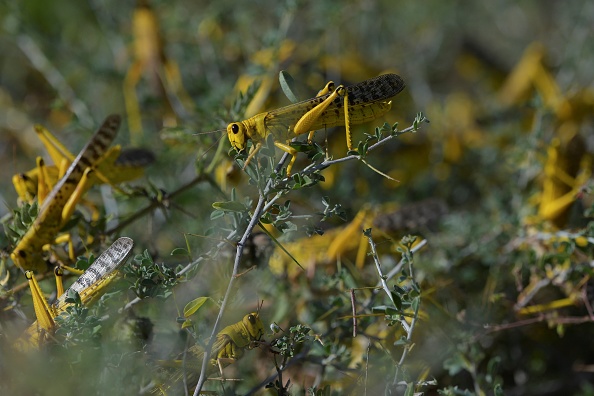
DO NOT PUBLISH Locust swarm threatens upcoming cropping season, puts food supply at risk
East Africa countries have been warned to brace themselves for a second locust invasion in the next one to two months. This even as desert locusts are expected to continue breeding and spreading during the coming months due to favorable climatic conditions (throughout the March to May rainfall season), as forecasted by IGAD Climate Prediction and Application Centre –ICPAC.
Usually the period between March to May is the main cropping season for many countries in Eastern Africa(most of Kenya, Uganda, Tanzania, southern South Sudan, southern Ethiopia and southern Somalia).
The swarms of locusts, which have now spread to eight countries (Kenya, Ethiopia, Somalia, Djibouti, Uganda, Tanzania, Sudan and Eritrea), have been laying eggs along their migratory paths.
These areas face the highest risk of new swarms invasion (see ICPAC Desert Locust Prediction Map).
 The eggs are expected to hatch between March and April, posing serious risks to the upcoming cropping season.
The eggs are expected to hatch between March and April, posing serious risks to the upcoming cropping season.
ICPAC says under a worst case scenario, the desert locusts will invade key production areas/bread-baskets of the region and cause significant crop losses during the March to May cropping season, and could potentially worsen the food security situation.
Some swarms have now reached northern Tanzania and north-eastern Uganda. There is a high likelihood that swarms could reach South Sudan at any time.
Climatic and ecological conditions suitable for locust reproduction and development are very favorable in most of northwestern Kenya, eastern to central Uganda and northern to western Tanzania.
The Food Security and Nutrition Working Group (FSNWG) stated in their recent special report on Desert Locust that “Most affected areas are currently facing Crisis (IPC Phase 3) or Stressed (IPC Phase 2) food insecurity.
That there are at least 9.75 million people living in areas affected by desert locusts in Ethiopia, Kenya, and Somalia and are currently or projected to be in a food Crisis.
The IGAD Heads of State and Government during their 34th Extraordinary Summit, called for increased coordination given the fact that the locust invasion transcends the IGAD region, affecting also neighboring gulf states and countries in the Arabian Peninsula.
“We call upon international and development partners to support the ongoing efforts of IGAD Member States and East Africa to fill in requisite financial, technical and logistical capacity gaps to effectively fight the locust invasion”.
“The heavy rainfall brought by the extreme positive Indian Ocean Dipole (IOD) and the unusual cyclonic activity contributed to the current Desert Locust upsurge. In 2019 the warming of the Indian Ocean led to 8 cyclones, the highest number on record so far, forming in a year over the Indian Ocean.
The extreme positive IOD, one of the highest on record, led to one of the wettest October to December rainy seasons in many parts of East Africa. According to recent research, this type of extreme positive IOD events could double in frequency under a scenario of 1.5 °C warming.” said Dr. Guleid Artan, director of ICPAC.






